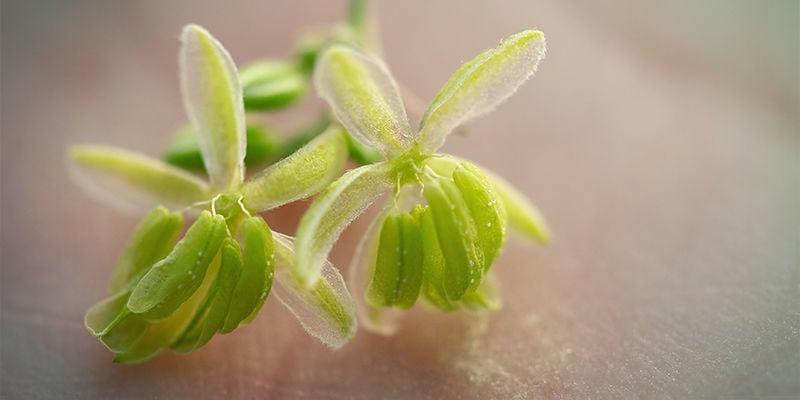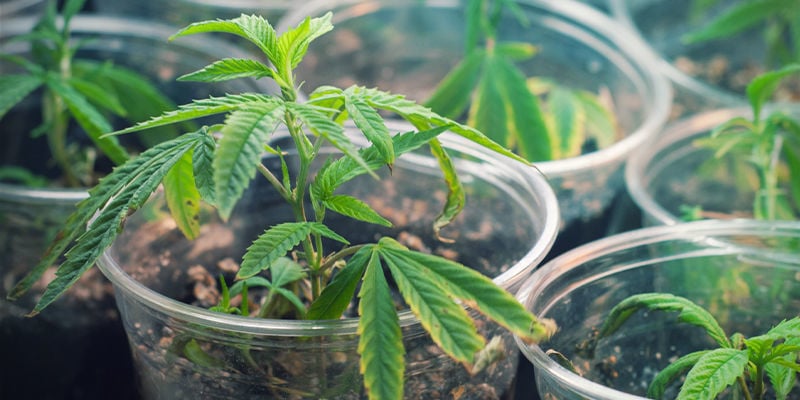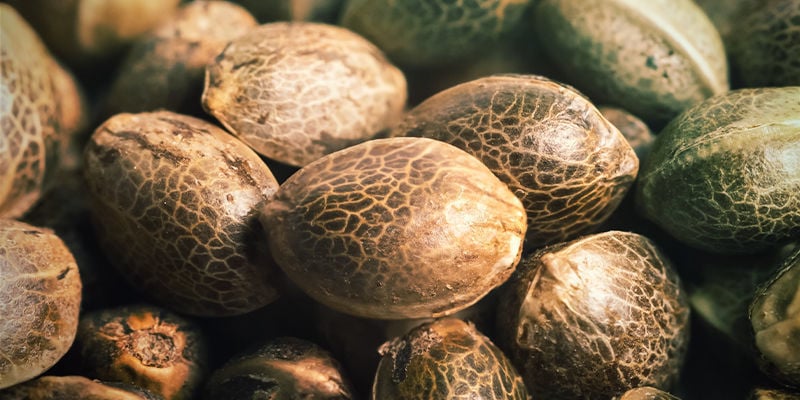
What Are F1, F2, And F3 Cannabis Seeds?
There are a lot of terms in the world of cannabis cultivation, and even more in the world of cannabis breeding. In this article, we look at terms such as F1, F2, F3, polyhybrids, and backcrossing, and ask: "How do you breed your own strain of cannabis?".
Breeding new cannabis strains is a whole different game to cultivation. Taking years of painstaking work, and requiring a huge amount of expert knowledge, it’s a fascinating if not daunting realm. In this article, we look into some essential terms that relate to breeding and stabilising new strains of cannabis. By the end of this article, you’ll have a good idea of the difference between F1, F2, and F3 cannabis seeds, among other key terms.
The basics of genetics

Terms relating to genetics are invoked a lot in discussions about cannabis, but what do they really mean? When it comes to buying cannabis seeds and growing them, you don’t need to understand a whole lot about cannabis genetics, aside from the basics of the particular cultivar you’ve chosen.
However, if you want to delve into the world of cannabis breeding, then there are some things you must understand if it’s to go well. Of course, you can just pollinate some females and see what happens, but without a little knowledge, you have no way of securing any of the rewards that come from this.
What are F1, F2, and F3 selections?
When browsing cannabis content, you may see a sentence like this: “This strain is the progeny of an F1…”. Sounds good, but what is it actually saying? In cannabis breeding, different generations are referred to as F1, F2, F3 and so on, with each subsequent number referring to a subsequent generation, getting further away from the pure, stable parent strain.
The “F” stands for “filius”, which is Latin for “son”. Though, in actual fact, what people are ultimately after are the THC-producing daughters. With each generation, the chosen traits, or phenotypes, become more stable, until eventually each seed produced will exhibit a predictable and reliable phenotype.
How to create new cannabis strains

Creating a new strain of cannabis can be as simple as crossing two strains and seeing what happens. But if you leave it here, you’ll likely only get a single generation of a particular “strain”. To create a stabilised strain, or “cultivar”, one which persists over generations, you need to carefully cross and backcross plants with the desired traits until they stabilise. In what follows, we explain the basics of what you need to know about this process.
F1
The first generation of plants resulting from a crossing are referred to as F1. These plants display half of each parent's genes, and as a result will be close to what the breeder desired. Say one parent strain has dominant genetics, AA, while another has recessive, aa. The resulting F1 will have Aa genetics, and will exhibit traits that are a combination of the two parents.
Usually, an F1 is close to what you’re ultimately trying to achieve, but it is not the end product. Even though all F1 specimens may appear the same, there’s a huge amount of diversity bubbling away beneath the surface, ready to show itself in their offspring.
F2
The next stage is to cross two F1 plants together. In doing so, you’ll find that the resulting offspring do not all show an Aa genetic profile. In this line of plants, the dominant gene (A) will begin to resurface, showing in more than half the offspring.
For instance, if you had four plants, two would be AA, one would be Aa, and one would be aa. So in the F2 generation, only 25% of the plants actually exhibit the desired phenotype. Dominant alleles (genes) are deemed dominant because they are far more likely to appear in offspring compared to recessive ones. If left unchecked, F2 plants would breed together, and, eventually, would more or less return back to the dominant parent that you began with, losing all of the recessive genes along the way.
What can you do about it?
F3
This third generation is where stabilisation begins (but not where it ends). Those plants with AA genetics should not be used, as they only contribute dominant genes, wiping out the recessive ones. Rather, an Aa and aa should be bred together. Their offspring will then show 50% Aa and 50% aa—much closer to what we want. If you breed two Aa’s together, then you’d be repeating the process of breeding two F1’s together, resulting in a majority of AA offspring. That’s why you need to introduce a plant with all recessive genes.
In reality, you can’t “see” exactly what genes the plants have, but you can see what traits they exhibit, and infer from that. If you want short plants with high yields, then you only breed the plants together that show these characteristics, and discard the rest.
Three generations is not the end of the stabilisation journey. You can go on crossing for many more generations (for example, producing F4’s and F5’s) if you want to create a truly stable strain.
IBL strains

IBL stands for “inbred line”, and it is at this point that a cultivar can be considered stable. This is the point you eventually want to reach from breeding F1’s, F2’s, F3’s, and so on. Now, if you breed two IBL’s together, you can expect every one of the offspring to display the same phenotype. If not, then keep crossing!
IBL’s can take years to create, depending on how many generations it takes. So if you’re serious about breeding, then prepare to be in it for the long run. You won’t create the world’s best new strain in a single crop.
For commercial breeders, IBL’s are the ultimate goal. These seeds produce very similar and reliable plants, meaning they can be sold with a high degree of certainty regarding what they’ll produce. If a strain hasn’t reached this stage, then accurate claims can’t be made about the plants these seeds will produce.
Polyhybrid cannabis seeds

Polyhybrids are made by crossing two F1 strains. Remember that F1’s are full of genetic diversity, so when you breed two together, there’s a lot to play with. Predicting what this process will create is difficult, but the results can be extraordinary. That said, stabilising polyhybrids can take even longer.
Compared to creating F1’s, doing so with polyhybrids is much more of a gamble. That said, many breeders will pursue this route with something in mind—it’s just that the scope of unexpected results is much greater.
S1 cannabis seeds
S1 cannabis seeds are produced when a strain is bred with itself—also known as “selfing”. This isn’t just crossing a plant with another of the same strain, but is literally breeding a single plant with itself.
To do this, female plants are stressed so that they become hermaphrodites, exhibiting fertile male and female sexual organs. They are then able to pollinate themselves and produce seeds.
What is genetic backcrossing?
Backcrossing is used to introduce a desirable trait, or remove an undesirable trait, from a strain.
Say you like a plant because it has a high THC production, but it also has poor pest resistance. In this case, you can breed it with another plant with good pest resistance. If all goes well, the resulting F1’s will have better pest resistance, but diminished THC production. To combat this, you can then backcross this F1 with a clone of the parent with high THC production, and the offspring will have high THC production and greater pest resistance.
In reality, this takes several generations in order to maximise and stabilise both traits. Backcrossing is a very important practice in breeding, and allows breeders to introduce and remove specific traits with impressive accuracy.
Breeding cannabis: There’s a lot to it

This article has only scratched the surface when it comes to cannabis breeding, but consider it an introduction to a complex but rewarding world. The realm of genetics is deep and fascinating; if you’re serious about breeding, then it’s going to take a lot of trial and error to achieve success. However, every breeder has to start somewhere, so we can only hope to inspire you to take the first steps in your cannabis breeding journey.
-
 4 min
5 September 2024
Indica VS Sativa: Does It Still Matter In 2025?
Since their introduction over 200 years ago, the terms "indica" and "sativa" have served as a principal way to categorise cannabis plants based on their appearance and supposed effects. But just...
4 min
5 September 2024
Indica VS Sativa: Does It Still Matter In 2025?
Since their introduction over 200 years ago, the terms "indica" and "sativa" have served as a principal way to categorise cannabis plants based on their appearance and supposed effects. But just...
-
 5 min
18 September 2023
Landrace Strains: The Oldest Cannabis Strains
Landraces can be traced back many centuries to their respective continents and countries. Still, it wasn't until fairly recently that these strains were exported and became the backbone of the...
5 min
18 September 2023
Landrace Strains: The Oldest Cannabis Strains
Landraces can be traced back many centuries to their respective continents and countries. Still, it wasn't until fairly recently that these strains were exported and became the backbone of the...
-
 7 min
8 March 2020
Seeds Vs. Clones: A Definitive Guide To The Pros And Cons
Trying to decide between starting your grow from seed or clones? This impartial guide will walk you through all the advantages and disadvantages, explain exactly what a clone is, and review times...
7 min
8 March 2020
Seeds Vs. Clones: A Definitive Guide To The Pros And Cons
Trying to decide between starting your grow from seed or clones? This impartial guide will walk you through all the advantages and disadvantages, explain exactly what a clone is, and review times...
-
 3 min
18 June 2018
How To Recognise High-Quality Cannabis Seeds
Seeds are the beginning of life. Sorting out the good seeds from the bad is essential to growing some dank nugs. Check out this article to learn the tells of good and bad cannabis seeds.
3 min
18 June 2018
How To Recognise High-Quality Cannabis Seeds
Seeds are the beginning of life. Sorting out the good seeds from the bad is essential to growing some dank nugs. Check out this article to learn the tells of good and bad cannabis seeds.





 United States
United States














